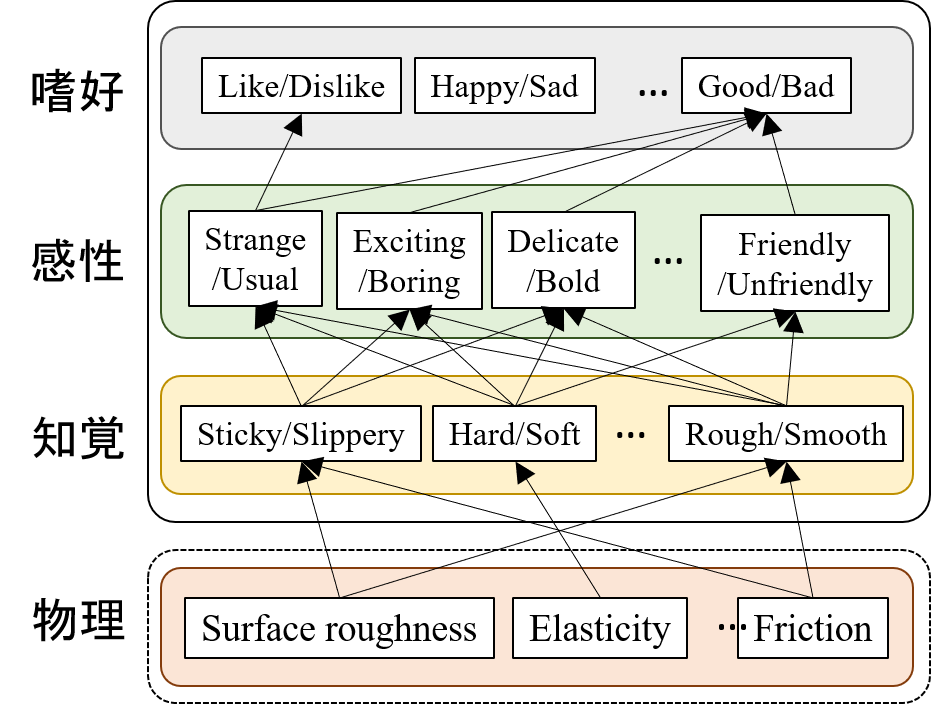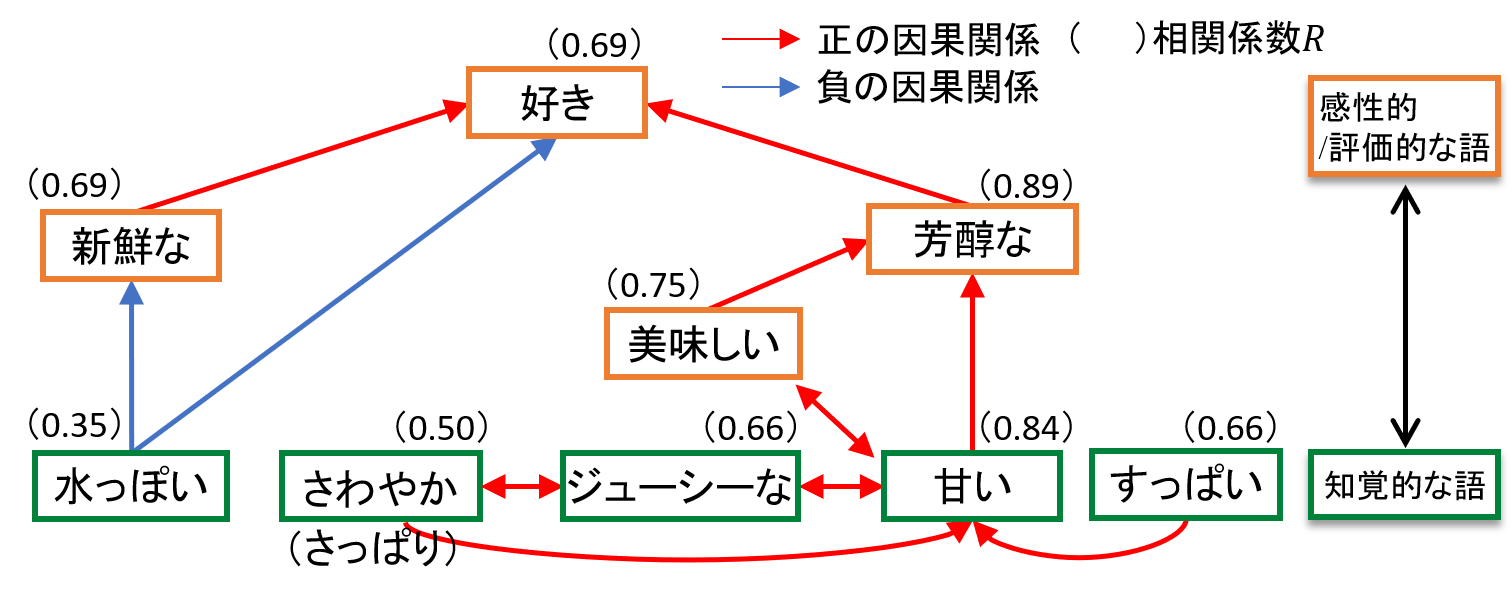感性の本質は,多様(多次元かつ多階層)で,ダイナミック(時間変化する)かつ個人差が著しいことにあります. そんな感性を分析し,製造業に活かすための技術を開発しています. また,実際のものづくり/システムづくりに供したいとの思いから,様々な企業との共同研究を行っています.
The human affective status is defined in the information space which is multidimensional, multilayered, and dynamic. We are studying analytical techniques for comprehending such human internal responses. Also, to be dedicated to manufacturing and service industries, we have been collaborating with companies in various fields.
知覚・感性体験の多階層・多次元モデルを構築する技術
Multi-layered and multi-dimensional modeling of human feelings and perception
 刺激に暴露すると様々な主観的体験が生じます.
触れることを例にすると,粗い・柔らかい・温かいといった触対象の物理的側面に関する知覚的体験から,複雑な・高級感があるといった対象の属性および感性に関する体験, 好き/嫌いの嗜好などがこれらに含まれます.
こういった体験は,意味的に多階層かつ多次元の構造を構成します.
われわれは,官能評価の結果から多変量解析技術を用いて,この階層構造を構築する技術を開発しています.
この分析技術を用いれば,製品の感性の設計や個人差の分析を行うことができます.
刺激に暴露すると様々な主観的体験が生じます.
触れることを例にすると,粗い・柔らかい・温かいといった触対象の物理的側面に関する知覚的体験から,複雑な・高級感があるといった対象の属性および感性に関する体験, 好き/嫌いの嗜好などがこれらに含まれます.
こういった体験は,意味的に多階層かつ多次元の構造を構成します.
われわれは,官能評価の結果から多変量解析技術を用いて,この階層構造を構築する技術を開発しています.
この分析技術を用いれば,製品の感性の設計や個人差の分析を行うことができます.
Exposure to objects/stimuli causes various subjective experiences including perceptual, affective, and hedonic
responses. These subjective responses are typically expressed by using adjectives and construct
a multi-dimentional and multi-layered information structure. We develop techniques for establishing such
structures based on psychophysical experiments or sensory appraisal.
They help us understand the linkages of human responses and design affectively attractive products.
• Related publications:
[日本語1]
[日本語2]
[English 1]
[English 2]
[English 3]
感性のダイナミクス: 時間変化する感性・知覚の動的因果関係モデリング
Affective dynamics: Dynamic causality modeling for temporally evolving affective and sensory responses
 人の感性および知覚的応答は,刺激を体験した直後から目まぐるしく変化します.
このような変化を捉えるための官能評価手法として,TDS法やTCATA法があります.
これらの方法から多次元時系列データが得られますが,それらの特性を調べたり,適した分析手法を開発しています.
例えば,図はいちごを食した際の味覚,嗅覚,食感,感性,嗜好の時系列データから,それらの因果関係を図示した例です.
人の体験が時系列でどのように変化するかだけでなく,なぜ変化するのかを解き明かすための分析技術です.
人の感性および知覚的応答は,刺激を体験した直後から目まぐるしく変化します.
このような変化を捉えるための官能評価手法として,TDS法やTCATA法があります.
これらの方法から多次元時系列データが得られますが,それらの特性を調べたり,適した分析手法を開発しています.
例えば,図はいちごを食した際の味覚,嗅覚,食感,感性,嗜好の時系列データから,それらの因果関係を図示した例です.
人の体験が時系列でどのように変化するかだけでなく,なぜ変化するのかを解き明かすための分析技術です.
Our sensory and affective/emotional experiences temporarily evolve after exposure to stimuli.
The TDS and TCATA methods are potent approaches to record such multiple time-variant subjective responses.
We are developing mathematical methods to analyze these time-series data. For example, the figure shows temporal
causalities among the sensory and affective responses when eating strawberries. It helps comprehend
how and why human experiences temporarily change.
• Related publication:
[日本語]
[English]
主動作分析を用いたTDS/TCATAデータの時系列解析
Principal motion analysis of TDS/TCATA data
時系列官能評価法であるTDS/TCATA法から得られるデータの多次元時系列特性を活かした解析手法を開発しています.
多くの手法は,時系列データから平均,最大値などの特徴量を算出し,それらを分析対象としますが,その過程で時間の情報が失われてしまうという懸念があります.
われわれの手法では,経時的な情報を保ったままの分析が可能です.
下図左と中央は,梅干しから得られたTDSカーブの第一,第二主動作であり,カーブの連動性を示します.
右は,これらの主動作の大きさに基づいて,10種類の梅干しの特性分布を示します.
従来の官能評価法よりもはるかに製品を弁別する能力が高くなります.
TDS/TCATA methods provide time-series profiles of sensory and affective responses to stimuli.
Principal motion analysis (PMA) can extract common patterns out of such data. Principal motions include the
multidimentional and temporal information of original data and allow us to analyze how human responses
temporally develop. The left two figures show the 1st and 2nd principal motions while eating plum pickles.
The right figure indicates how ten types of plum pickles differ from each other.
• Related publication:
[日本語]
[English]
Bootstrap リサンプルされたTDSカーブへのデータサイエンス・アプローチ
Data-scientific approach for bootstrap-resampled TDS curves
 時系列官能評価法であるTDS法は,食品科学分野を中心に普及しており,他分野への適用も進んでいます.
TDS法の中心的な出力結果であるTDSカーブへのデータサイエンス・アプローチは大きな期待が持てますが,
カーブのサンプル数が小さいという問題が障壁となっています.
われわれは,
Bootstrapリサンプルの手法によってTDSカーブを大量に生成することによって,この問題を解決しつつあります.
同手法は,TDSカーブの分析において今後,重要な役割を果たしていくとともに,本研究チームがその先導役を果たしていきます.
時系列官能評価法であるTDS法は,食品科学分野を中心に普及しており,他分野への適用も進んでいます.
TDS法の中心的な出力結果であるTDSカーブへのデータサイエンス・アプローチは大きな期待が持てますが,
カーブのサンプル数が小さいという問題が障壁となっています.
われわれは,
Bootstrapリサンプルの手法によってTDSカーブを大量に生成することによって,この問題を解決しつつあります.
同手法は,TDSカーブの分析において今後,重要な役割を果たしていくとともに,本研究チームがその先導役を果たしていきます.
The TDS method, a promising time-series sensory evaluation, has been increasingly used in many industries.
Data-scientific approaches are expected to be applied on the major outputs of this method, TDS curves; however,
the small sample size of the curves deter the application of many analyses.
We are solving such problems by using the bootstrap resampling of TDS curves.
Our approach will be playing an important role in the analyses of TDS curves, and we are leading the analysis
techniques.
• Related publication:
[English 1]
[English 2]
[English 3]
[English 4]
[English 5]
[English 6]
 刺激に暴露すると様々な主観的体験が生じます.
触れることを例にすると,粗い・柔らかい・温かいといった触対象の物理的側面に関する知覚的体験から,複雑な・高級感があるといった対象の属性および感性に関する体験, 好き/嫌いの嗜好などがこれらに含まれます.
こういった体験は,意味的に多階層かつ多次元の構造を構成します.
われわれは,官能評価の結果から多変量解析技術を用いて,この階層構造を構築する技術を開発しています.
この分析技術を用いれば,製品の感性の設計や個人差の分析を行うことができます.
刺激に暴露すると様々な主観的体験が生じます.
触れることを例にすると,粗い・柔らかい・温かいといった触対象の物理的側面に関する知覚的体験から,複雑な・高級感があるといった対象の属性および感性に関する体験, 好き/嫌いの嗜好などがこれらに含まれます.
こういった体験は,意味的に多階層かつ多次元の構造を構成します.
われわれは,官能評価の結果から多変量解析技術を用いて,この階層構造を構築する技術を開発しています.
この分析技術を用いれば,製品の感性の設計や個人差の分析を行うことができます. 感性の因果と動きを計算し,モノ・サービスの感性価値を設計する
感性の因果と動きを計算し,モノ・サービスの感性価値を設計する 人の感性および知覚的応答は,刺激を体験した直後から目まぐるしく変化します.
このような変化を捉えるための官能評価手法として,TDS法やTCATA法があります.
これらの方法から多次元時系列データが得られますが,それらの特性を調べたり,適した分析手法を開発しています.
例えば,図はいちごを食した際の味覚,嗅覚,食感,感性,嗜好の時系列データから,それらの因果関係を図示した例です.
人の体験が時系列でどのように変化するかだけでなく,なぜ変化するのかを解き明かすための分析技術です.
人の感性および知覚的応答は,刺激を体験した直後から目まぐるしく変化します.
このような変化を捉えるための官能評価手法として,TDS法やTCATA法があります.
これらの方法から多次元時系列データが得られますが,それらの特性を調べたり,適した分析手法を開発しています.
例えば,図はいちごを食した際の味覚,嗅覚,食感,感性,嗜好の時系列データから,それらの因果関係を図示した例です.
人の体験が時系列でどのように変化するかだけでなく,なぜ変化するのかを解き明かすための分析技術です.
 時系列官能評価法であるTDS法は,食品科学分野を中心に普及しており,他分野への適用も進んでいます.
TDS法の中心的な出力結果であるTDSカーブへのデータサイエンス・アプローチは大きな期待が持てますが,
カーブのサンプル数が小さいという問題が障壁となっています.
われわれは,
Bootstrapリサンプルの手法によってTDSカーブを大量に生成することによって,この問題を解決しつつあります.
同手法は,TDSカーブの分析において今後,重要な役割を果たしていくとともに,本研究チームがその先導役を果たしていきます.
時系列官能評価法であるTDS法は,食品科学分野を中心に普及しており,他分野への適用も進んでいます.
TDS法の中心的な出力結果であるTDSカーブへのデータサイエンス・アプローチは大きな期待が持てますが,
カーブのサンプル数が小さいという問題が障壁となっています.
われわれは,
Bootstrapリサンプルの手法によってTDSカーブを大量に生成することによって,この問題を解決しつつあります.
同手法は,TDSカーブの分析において今後,重要な役割を果たしていくとともに,本研究チームがその先導役を果たしていきます.